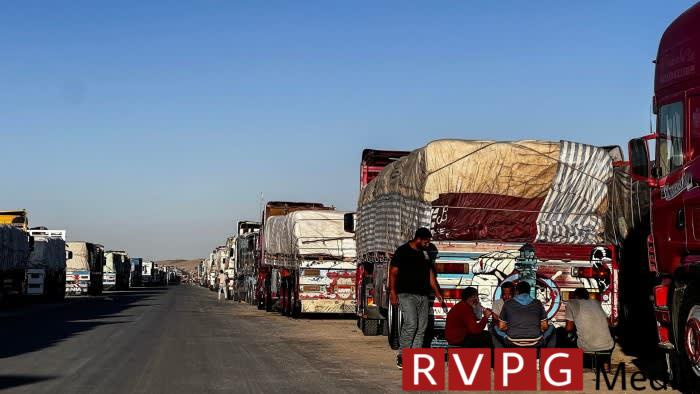The flow of essential food and medicine into the Gaza Strip – already severely restricted by the eight-month war – has slowed to a minimum after Israeli troops entered Rafah this week and paralyzed traffic at two key border crossings.
The United Nations has only 15,000 liters of fuel left for generators – including those in hospitals – and vehicles in the southern Gaza Strip, less than 10 percent of daily needs, said Scott Anderson, deputy director of UNRWA, the U.N. agency for Palestinians in Gaza.
After nearly three days of suspended humanitarian aid convoys, warehouses will run out of flour and prepared meals within a few days, he said.
Israel took control of the Gaza side of the Rafah border crossing with Egypt on Monday and temporarily closed the Kerem Shalom crossing on the Israeli side of the border after a mortar attack killed four soldiers on Sunday.
After the White House called the closures “unacceptable” on Tuesday night, Israeli officials said Kerem Shalom had reopened, but U.N. officials said only a small number of trucks had been cleared by Israel and the fighting made the U.N. aware impossible to do so. Pick them up.
“If the crossing remains closed and we cannot get fuel to run the generators, the situation will be more than catastrophic,” said Dr. Jamal al-Hams, director of the Kuwaiti hospital in Rafah.
Another U.N. official said humanitarian organizations had already begun rationing their fuel use. The official said not all fuel supplies in the Gaza Strip were accessible because storage facilities were located near the fighting.
A smaller corridor from Israel to the northern Gaza Strip called Erez remains a bottleneck as trucks have to enter through holes in the border fence, even though Israel declared the crossing open during U.S. Secretary of State Antony Blinken’s April 30 visit.
The Israeli military said about 60 trucks entered Erez on Tuesday, up from more than 500 on all routes before the war began on October 7.
“Without a predictable and reliable pipeline, the impact is immediate even after two days of closure,” Anderson said from a UNRWA office in Rafah.
“The impact on fuel is the greatest – hospital generators will be shut down in three days, impacting people in intensive care units and babies in incubators – but here literally everything depends on the fuel supplied, from water supplies to waste disposal.”
With the war in Gaza entering its eighth month, aid deliveries have been precarious and have strained Israel’s relations with the United States. The State Department is expected to present an assessment later on Wednesday of whether Israel has complied with its obligations under U.S. international humanitarian law and the U.S. to facilitate the transfer of aid.
That assessment, forced on the White House in February by House Democrats alarmed at the toll Israel’s war against Hamas was taking on Palestinian civilians, will confirm whether Israel acted to “arbitrarily destroy the… To refuse, restrict or otherwise hinder delivery directly or indirectly.” any US-backed humanitarian assistance to Gaza.
Israel says it sets no limits on how much humanitarian aid can enter Gaza and blames the UN and other organizations for their inability to distribute it.
The U.S. is providing aid to the Palestinians through various channels, including a currently suspended annual commitment of about $400 million to UNRWA, the USAID program, and contributions to the World Food Program and other aid agencies. Particularly worrying is the decision by the far-right Finance Minister Bezalel Smotrich to withhold hundreds of tons of flour at the port of Ashdod for several weeks earlier this year.
Several aid organizations, including Oxfam and the Norwegian Refugee Council, said earlier this week that the total amount of food that entered Gaza in the first roughly 180 days of the war was less than half the amount needed for humanity’s survival.
They also reported a significant lack of progress on seven separate commitments by Israel to improve humanitarian access after the Israel Defense Forces killed seven World Central Kitchen workers in a bombing that the military acknowledged was a mistake.
A second part of the US assessment will examine whether Israel – or any other recipient of American military aid – has used US-provided weapons in a manner consistent with international law.
The White House last week delayed delivery of 3,500 bombs, including the large, 2,000-pound weapons that Israel had deployed in the Gaza Strip, killing large numbers of Palestinians in the densely populated enclave.
The delays were linked to U.S. concerns about the use of these weapons in Rafah, where more than a million Palestinians have sought shelter from the fighting in the rest of the devastated area, a senior U.S. government official said Tuesday evening.

Israel’s takeover of the Rafah border crossing came less than 24 hours after Israel issued an evacuation order for more than 100,000 civilians on the eastern edge of the border town. This area included several aid warehouses and infrastructure for the distribution of food and other essential supplies to the rest of the Gaza Strip.
Tens of thousands of Palestinians have fled much of Rafah since Sunday as market prices soared and Israeli bombings drew closer. Parts of the border town, whose population has grown to almost 1.3 million due to the influx of internally displaced people, resembled a ghost town on Wednesday morning.
“The situation is frightening beyond words,” said Ahlam Walid, a 34-year-old from Gaza City who shares a tent with his family and another. “The bombardment is continuous and getting closer and closer.”
The price of sugar has increased three times, vegetables have doubled and meat has disappeared from the market, she said.
Satellite visualization by Jana Tauschinski
